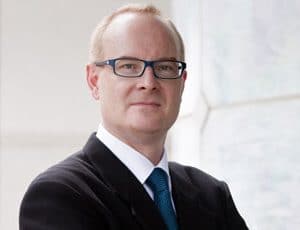
Revolutionize your brand in a fast-paced world


Executive global business strategist and advisor counselling on building strong brands that survive through any change
Request fees and availabilitySend a simple request. You’ll get a quick reply with fees and availability
About Martin
Keynote
Articles
Martin Roll is the founder and CEO of Martin Roll Company, and brings with him more than 25 years of top-level C-suite counselling experience. He is very experienced in engaging and advising clients at all management levels from business owners and C-suite leaders to functional staff across multiple industries and diverse cultures. He is an advisor to several global boards and prominent business families.
He is a highly accomplished keynote speaker at global conferences, an experienced conference moderator and board level/executive workshop facilitator. Martin Roll is in constant demand at some of the most influential business conferences and C-suite gatherings worldwide.
He teaches MBA, EMBA and Executive Education programs at Nanyang Business School (Singapore), and is a frequent guest lecturer at INSEAD and other leading global business schools. He is also an Associate Fellow at The Institute on Asian Consumer Insight (ACI) and has been a Senior Advisor to McKinsey & Company.
Martin Roll is a member of the global Advisory Council of Welspun Group (Mumbai), a non-executive board of director at the Scandinavian watch brand ORLO (Copenhagen) and a Senior Advisor to Cocoon Capital (Singapore).
Martin Roll is a business columnist with INSEAD Knowledge, a prolific management writer, and a regular commentator in global media. Martin Roll holds an MBA from INSEAD. He is the author of global bestseller “Asian Brand Strategy” (2015) and co-author of “The Future of Branding” (2016) with two new books in the pipeline.
Martin Roll has lived in Asia for two decades and serves clients on all continents.
Martin Roll is a very experienced and accomplished global speaker and presenter. He is a powerful and authentic thought-leader with great authority and excellent command of the stage and any global senior audience – from large-scale to boardroom size. He delivers a wealth of actionable insights, perspectives and best global practices. Martin Roll is in frequent demand at leading global summits and conferences and senior executive meetings around the globe.
See keynotes with Martin RollHow would you describe Yourself?
I stride to be at the forefront of developments and provide global thought leadership in the fields of strategy, leadership and brand/marketing. It is hard work and requires that you simply are fully up to date with latest research and developments in many important fields of management. I spend half my time as a keynote speaker and seminar leader/moderator, and the second half as an adviser across several types of companies and industries.
I am an adviser, mentor and facilitator to a selection of Asian family firms (among them some of the largest and most influential), Asian corporate firms and Fortune 500 firms among others.
I am covering almost all major industries, and am currently working as an adviser within cosmetics, luxury, hospitality, fashion retail, technology, pharmaceutical, retail, among others.
Clients are spread all over the world, and currently I see strong demand from the US and from Latin America. My Asian platform and emerging markets insights serve as a great advantage, and many clients and referring partners are expressing a growing need for new profiles across the US and Latin American speaking circuit.
Due to the type and the managerial level of my clients, I strive to deliver on the following 4 dimensions:
What are the values that are guiding you?
I think it is important to be ambitious, work hard and seek to make a difference to the world – in whatever field that you operate. Aspirations are important as they act as the strongest fuel for further achievements and advancements for humans. I keep high aspirations and try to be grounded at the same time. Things do take time. I want to be an architect on my own life, so that requires that you have to envision where you like to go, how to get there, and to know when you have arrived.
What is the message you hope people take away from your presentations?
I hope they get inspired to return to their offices seeking to achieve even better in the functional areas of marketing, branding, leadership, growth and globalization. My message is that in order to succeed on the global stage, which I believe most firms should aim for; people should always raise their bars, step outside the comfort zone, and be excellent in all endeavors. Easier said than done, but my message is that it is possible, and I hope to give people some of the crucial tools to that exactly that.
What is the feeling you would like people to take away?
A good feeling hopefully! You want to make sure they have had a good time and that they feel empowered, enlightened, and inspired to become better.
How do you prepare for speaking engagements?
It depends on the scope and scale of the speaking engagement. Every keynote speak and every moderation role is different and unique. I prefer in three ways: Firstly, I often speak to the client in advance to get a sense of what they want and who they are (or believe they are). Then I prepare the actual materials including any additional research and information I need to add in.
Finally, I leave everything behind which is the most important process as all insights, needs and requirements tend to blend together in my mind, and I see the overall big picture. Then I am ready for the speaking engagement. Once you have tried it so many times in all parts of the world as I have, you don’t think about it anymore. It becomes another day on the job, and you know how to fill out the role and responsibilities.
What do you gain personally from being a public speaker?
I enjoy public speaking very much. It is rewarding, and you meet with so many different types of people across many cultures all over the world every year. You definitely share knowledge and insights with the audiences, and hopefully that contributes to their success. That is primary goal. But I also find that public speaking and the interaction with the audiences provide an excellent platform for insights and experiences which helps one to keep updated. In other words, it serves as a laboratory for new ideas and issues, and I gain a lot also from meeting with so many professional and ambitious senior leaders and business owners every year.
I advise many family-owned businesses and the families behind them which is also a great pleasure to do. You get very close to the action and they tend – once the trust is established – to include you in all matters of business and life, and you end up being a very close aide and adviser to them. I enjoy that immensely.
I also enjoy teaching on the academic circuit. It keeps you updated and provides new insights and information about many important things as you interact and engage with both future leaders on the MBA track, and with senior leaders and company owners on the EMBA track. I am teaching MBA, EMBA and Executive level programs at Nanyang Business School (Singapore), INSEAD (Singapore) and CEIBS (Shanghai). Generally, I stay in contact with many of my students, and some of them become clients and others form part of my global network. So teaching is definitely worth it, it keeps you sharp and up to standard if you have to perform in top-notch academic settings as I do.
How much does humor factor into your keynotes and other speaking engagements?
The topics I cover are on the serious side, so humor does play a role, but only a secondary one. It is important to present these topics in a serious and managerial context, and too humor would actually dilute the importance of the topics.
What are the top three lessons within the field of branding that people should be aware of, and which you elaborate upon in your speeches?
Branding enhances shareholder value, it can become a catalyst for better leadership, it enables to drive a shared vision throughout the organization, and it can help to balance short- and long-term perspectives and performance.
There are 4 top lessons to remember:
How are your keynote presentations unique?
I guess the best persons to answer that question are the audiences watching it and engaging with me.
Do you have any unique memorable moments in your speaking career?
Most of the speaks and moderation roles I have had are unique. You always meet new people, always get an unexpected question to cope with on the spot, and things emerge differently to what you had prepared for. But that is what makes it joyful and fulfilling.
I spoke some years back at an Asian retail conference with 3.000 people attending my keynote speak. Last minute, I learned that the South Korean president would there because he wanted to hear my opening keynote speak. It led to interactions with the Korean government. A country which is close to my heart, I like the Korean people. I do lots of business and advisory there.
On another occasion, I spoke at a huge conference in Tehran, Iran. I flew via Dubai but stranded there for a while due to an emerging snow storm over Iran. In the end, one of the local airlines flew into Iran operated by Iranian pilots. I later learned from a Western pilot friend from Emirates Airlines that the Iranian pilots are really hardcore flyers and well-trained – and pretty much used to the rough conditions in their own backyard. We arrived in the middle of the snowstorm on a small cleared strip of the full-length run-way – the aircraft, a Boing 747, stopped 15 meters from the end of it. Well done! On the way out of Tehran, we left 5 mins before the airport closed for almost a week due to heavy snowstorms.
You learn the live with these moments. I enjoy it very much!
Can you give some insight as to why branding is so important?
Branding enhances shareholder value, it can become a catalyst for better leadership, it enables to drive a shared vision throughout the organization, and it can help to balance short- and long-term perspectives and performance.
Singapore Airlines is one of the best examples of this – they are brilliant in balancing well these issues. Samsung is another example of a company which moved from a pure diversified manufacturer towards a company with strong cash flows from branding. Coca-Cola, P&G and Gillette (now owned by P&G), Starbucks, L’Oreal and LVMH are other global brands which are very well-managed and which provide solid cash flows from brands and portfolio of brands.
Today, businesses and consumers are placing increasing importance on brands. Brands give consumers a sense of identity, stimulate their senses and enrich their life experiences. People have needs to affiliate and surround themselves with things they know well, trust and aspire to be. From a customer viewpoint, a brand is a signal of quality and creates a bond of trust with the manufacturers behind them.
Brand value is driven by margins that the brand is able to charge and the customer loyalty. These two issues have to be bench marked against competitors and provide differential advantages. However, if brands are well-known hence being valued very highly, they are also part of the public space and gets lots of attraction. The reasons for buying brands are that we have an emotional bond to them due to their ability to connect us to communities.
Psychological research demonstrates that brands are durable because people are cognitive misers. The modern society is overloaded with information, and the average person receives far more information than one can possibly digest properly. Therefore, people seek to simplify the world by relying on a variety of heuristics to minimize the amount of searching and information processing needed to make reasonable decisions.
Once people believe a brand works for a certain purpose or reason, they are less likely to seek out new information that challenges the assumptions. Sociological research also demonstrates why people are less likely to switch brands. Multiple elements like images, stories and associations are attached to a brand. As these elements are shared collectively by groups and networks of people, they form generally accepted conventions about brands. It is therefore relatively difficult for individuals to switch brands and thereby abandon these shared conventions.
A Chinese proverb states: “wealth shall not pass three generations”. The first generation builds wealth, the second manages it, and the third generation destroys it. This challenge often occurs when the next generation is less committed than the original founder.

However, there are family businesses which have overcome this challenge. Hoshi Ryokan, a
traditional Japanese guesthouse-styled hotel, was founded in year 718 and has spanned 46
generations. With proper processes and governance, family firms can rein successful for
generations.
Family and business are complementary assets
Sustainable value for family businesses is driven by Performance (business) and Platform
(family). Balancing the two drivers is critical. Optimizing performance is crucial to survival as it
generates income and dividends, while the platform must be fit for the family’s purpose.
One of the key characteristics of a successful family business is that it is integrates both “heart”
and “brain”.
The importance of ownership, management and family roles
The family should consider if they are the best suited to lead the business. Some considerations
are: if large future investments are necessary, whether there will be a more capable or
experienced owner, and whether future generations are interested in owning the business. It may
be a difficult decision for a family to invite external investors on board or sell the entire business,
but a different ownership structure may sometimes help the business attain access to capital,
valuable know-how, global market access and leadership diversity.
Families should also be prepared for outside take-over attempts and ensure their ownership
structure can meet those challenges. Despite owning 70% of the shares, the Hermès family
owners could have lost the company to LVMH if they had not created a holding company that
had the first right to buy any family shares.
The key to selecting the right business leader is to implement a professional process where
potential family talents are benchmarked against external talents. This selection is often loaded
with conflicts due to mismatched expectations, communication breakdowns and unclear
succession plans. In Asia, communication between generations is typically less direct. When
combined with inherent respect for seniority, open discussions and potential disagreements tend
not to surface. In the next decade, many Asian family firms will have to go through succession.
When LEGO found itself struggling to transform its business, the family decided to nominate
Jorgen Vig Knudstorp, a former McKinsey consultant within the LEGO group strategy team, as
CEO. LEGO later regained its market leadership.
Successful family businesses are characterized by:
Family firms should embrace change
Leadership in the 21st century will be challenged by constant change, geopolitical volatility,
technological disruptions, economic and political uncertainty, and shifting demographics.
Next generation family business leaders must learn to view challenges from both a short- and
long-term lens, build strength and identity, balance global outlook and local insights, and
develop strong leadership strategies.
The success of family business leaders will be defined by their ability and willingness to drive a
powerful transformation across their organizations: To be Daring, Bold and Different.
Send a simple request. You’ll get a quick reply with fees and availability